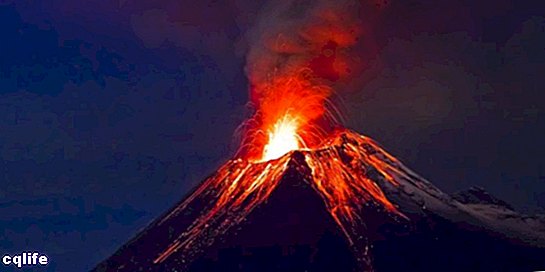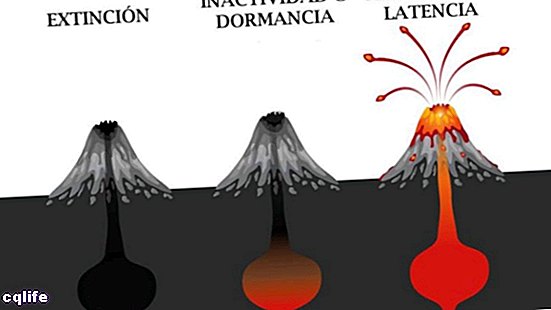- What is a volcano?
- Characteristics of the volcanoes
- How are volcanoes formed?
- Types of volcanoes
- Parts of a volcano
- Volcanic eruption
- Volcanoes of Mexico
We explain everything about volcanoes, how they are formed, their parts and other characteristics. Also, the main volcanoes in Mexico.

What is a volcano?
A volcano is an opening in the earth's crust, through which magma or lava can emerge, along with gases, ash and other materials from the depths of the earth. They can be found in other planets Y satellites from space.
Volcanoes are quite frequent in the Earth crust, especially in regions of intense seismic activity, and can be found on the continental shelf or on the ocean floor. Their eruptions, which is how the boiling magma spill to the outside is called, they are usually cyclical and sporadic, varying in intensity and destructive potential.
They are considered one of the main sources of rocky materials in the earth's crust. In addition, they are one of the main natural environmental threats, capable of producing huge forest fires, throwing tons of material into the atmosphere (gases and ashes, especially) and therefore altering the chemical balance of the biosphere land.
Many mass extinctions in Earth's geological history are attributed to intense and / or prolonged episodes of volcanic activity.
Volcanoes are studied by geologists and have an important correlation with terrestrial seismic activity, such as earthquakes Y movements tectonic. Volcanoes take their name from the Greek god Hephaestus, Vulcan.
Recommended documentaries:
- Volcanoes, designed to destroy
- A Volcanic Odyssey (English)
- What is a volcano? (English)
Characteristics of the volcanoes

Volcanoes can have many shapes, but generally they consist of a conical structure resulting from the deposition of materials after successive eruptions. They can reach heights of even 8000 meters above sea level.
The materials that make them up can be diverse, depending on the type of volcano and the nature of the subsoil where they occur.
On the other hand, they have a long and diverse life cycle, consisting of three stages:
- Activity or latency state. When volcanoes can erupt at any time;
- Inactivity or dormancy. When volcanoes show certain signs of activity, but haven't had eruptions in centuries;
- State of extinction. When they have not had an eruption in 25,000 years or more, although it is not possible to completely rule out that they revive at a certain time.
How are volcanoes formed?
Volcanoes usually form on the edge of the tectonic plates, especially where the subduction of one under the other has occurred, that is, where two plates have collided and one of the two deforms downwards, submerging in the hot magma of the lithosphere.
Thus, its local concentration increases, which eventually produces a burst back towards the surface. However, there are "hot spots" devoid of plate contact, where magma is naturally more likely to emerge.
Volcanoes are a natural phenomenon of readjustment of the surface layers of the planet. They tend to produce new igneous rocks and cover the surface with materials that, upon cooling, will form new ones. reliefs.
Types of volcanoes

There are different types of volcanoes, depending on their place of formation and their specific shape. The most frequent are:
- Stratovolcano. A type of volcano of great height and conical shape, made up of numerous layers or strata of hardened lava, the result of previous eruptions, as well as lapilli and hardened ash. They usually exceed 2,500 meters in height and are found on the continental plates.
- Slag cone. Conical mounds of volcanic material accumulated around a volcanic chimney. This material is known as "slag", it is usually glassy and contains trapped gas bubbles, as the magma cools rapidly. Its height can vary between ten and hundreds of meters in height.
- Volcanic caldera.Contrary to the previous ones, they have a sunken or depression shape, the product of landslides or internal collapses of the volcano, in which thermal water, geysers or even volcanic islands are usually housed.
- Shield volcano. These are large volcanoes, formed by basalt layers resulting from successive eruptions. They have a gentler slope, that is, less steep, and usually have recurrent eruptions over thousands or millions of years.
- Volcano submarine. Formed in the geological crevices at the bottom of the ocean, generally in the regions near the oceanic ridges. Its eruptions tend to greatly alter the chemistry of the surrounding seas and add new layers of matter to the ocean floor, as the water cools the magma very quickly. There could be thousands or millions of them today, since the study of the seafloor is a relatively new possibility in the geology.
Parts of a volcano
Volcanoes usually have certain differentiated elements.As we have seen, volcanoes can have very different shapes, but a “classic” or stereotypical volcano basically consists of:
- A magma chamber. Which is the huge deposit of molten rock under high pressure that underlies the volcanoes.
- A chimney. Which is the stretch that communicates the chamber with the outside, and can be long or short depending on the shape of the volcano (especially whether or not it has a magmatic chamber).
- A throat Which is the opening of the chimney right in its final stages.
- A vent. What is the opening as such through which the magma comes into contact with the air and releases gases into the atmosphere.
- A crater or "mouth" of the volcano. What is the limit between the "Mountain”Volcanic and the beginning of the vent.
- Secondary cones. In case there are chimney branches, which make up two or more volcanoes in one.
- An eruptive column. What is the jet of gas and other materials that is released into the atmosphere at the beginning of a volcanic eruption.
Volcanic eruption

It is known as volcanic eruption to the violent emission towards the earth's surface of gases, ashes and boiling magma, from the bowels of a volcano. They occur when the temperature of the molten rock inside the Earth's mantle rises and an internal explosion occurs, sending the liquid towards the surface.
This process can take an indefinite amount of weather, until the temperature and the pressure of the magma in the subsoil drops to acceptable levels and everything returns to normal.
Volcanic eruptions appear to be cyclical in some cases. However, it has not been possible to decipher what type of periodicity governs them, although they are almost always preceded by telluric movements and the emission of fumaroles (escapes of gases and vapors from the subsoil at very high temperatures).
In video:
- Why do volcanoes erupt?
- The most impressive volcanic eruptions
Volcanoes of Mexico

The Mexican territory is highly volcanic, as is Central America and the so-called Pacific Ring of Fire, which reaches Mexican coasts. It is estimated that there are around 566 volcanoes, not all of them recognized as such, the main ones being the following:
- The Popocatepetl. Located about 72 km southeast of the Mexican capital, it has a symmetrical conical shape and the enormous altitude of 5500 msnm, reason why its summits are covered with perennial glaciers. It is the second highest volcano in Mexico, but probably the best known.
- The Citlaltépetl. The highest volcano in all of North America, it rises to about 5747 meters above sea level, and is an active volcano. Known as Pico de Orizaba, it is located on the territorial limit of the states of Puebla and Veracruz.
- The Tacaná volcano. Located on the border between Mexico and Guatemala, it rises to about 4,092 meters above sea level and has thermal springs between 1,500 and 2,100 meters high, from which the Water at about 40-55 ° C, in a place known as hot water. Video: Ascent to the Tacaná volcano.
- The Nevado de Colima. An ancient volcanic massif that is located in the state of Jalisco and that is about 4,260 meters high, it has not presented any type of volcanic activity for a long time. As the name implies, its slopes are usually covered with snow during winter (November to March). Video: Ascent to Nevado de Colima.
- The Tortuga Island of Baja California Sur. This island of volcanic origin located in the Gulf of California, 40 km from the coast, is part of a shield volcano of a caldera approximately 1 km wide and 100 meters deep.
In video: The active volcanoes of Mexico
Follow with: Geothermal energy
